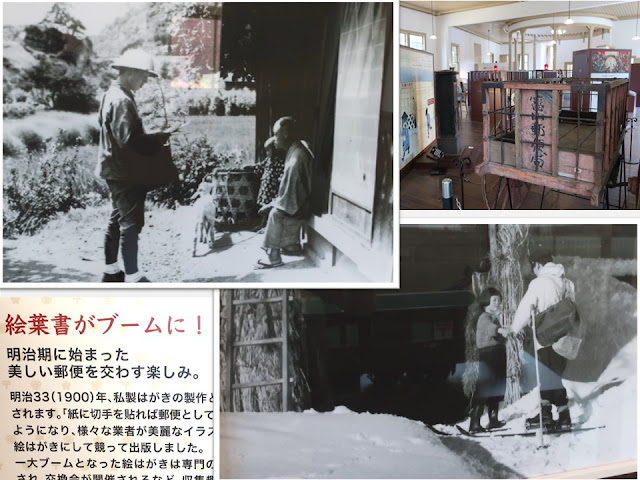“Meiji” means “Meiji period (1868-1912)”
and “Mura” means “village”. The huge open air architectural museum has
sixty-eight buildings built in the period in which
Japanese modern era started. I focus on buildings for ordinary people including
part 1 of this article: Meiji
Mura (1/2) 、博物館 明治村(part
1)
100万㎡の敷地に、全国の明治時代の建造物68施設を移築し、入館できるようにしています。このブログでは、庶民が通った劇場や銭湯、移民として海外へ渡った人の家を紹介します。
Uji Yamada Post Office in Mie prefecture、宇治山田郵便局舎(三重県)
It was built in 1909. There are various exhibits about mails inside the building.
1909年竣工。内部には郵便に関する様々な品が展示されています。
The job of post-person is not only delivery but also communication. They know the conditions of locals well!
郵便は物を届けるだけの仕事ではないですね。
The role of seasonal greeting cards is declining. Those were important communication tool before e-mail was spread. I send New Year's cards even until now in order to inform of my situation, because the greeting via e-mail doesn't continue.
今では役割を終えつつある年賀はがきと暑中見舞いですが、メールがない時代は旧交(舊交)をつなぐツールだったのですね。私は年賀状だけ送っています。メールだとやりとりが途絶えました。
Gymnasium for Martial Arts, Fourth National High School、第四高等学校武術道場
It was built in 1917. There is a space for Judo in front and is the one for Kendo (Japanese fencing) in behind. The one for Kyudo (Japanese archery) is behind the building. I can easily imagine boys who were into training to become strong.
1917年竣工、石川県(今の金沢大学です)。手前が柔道場、その奥に剣道場、更に奥には弓道場。鍛錬に明け暮れた若者たちの雰囲気を感じました。
Japanese Immigrants’ Assembly Hall in Hawaii、ハワイ移民集会所
It was built in 1889 in wetland of Hawaii, therefore it has a bridge to go inside the community center.
Japanese were prohibited to go abroad in 1635 by the feudal government. When the successive modern government established and permitted going abroad at the same time (1868), 153 people did it; how brave they were! In 1881, the king of Hawaii came to Japan and asked to our emperor to dispatch workers. Japanese government promoted immigration policies. The wage was ten times as much as the Japanese farmers! The Hawaii Kingdom ended in 1895 and was annexed by U.S.A. Japanese immigrants worked mainly in sugar production. There are many things I don’t know about Japanese people.
1889年頃竣工。湿地にあったので、建物に入るための橋があります。建物内には、移民に関して展示されています。
1868年、153名が移民。明治元年です。思い切ったものです。1881年、ハワイ国王が来日し、労働力不足を理由に明治天皇に移民を要請。国主導の移民が始まりました。賃金は国内農民の約10倍、しかし1895年、ハワイ王国は終わり、その後アメリカに併合されました。砂糖づくりの仕事が主でした。知らなかったことがたくさんあります。
The bell of Pepekeo farms、ペペケオ耕地の鐘
The bell was stroked at the wake-up-time and so on. Workers woke up at 4:30 AM, started working at 6 AM, finished it at 4:30 PM. They took lunch time for 30 minutes. They worked 10 hours a day (12 hours in sugar factory) and six days a week. However, the working hours were probably less than the ones in Japan back then.
起床や作業の合図に使われた鐘です。起床は4時半、作業開始は6時、16時半まで働きました。昼食休憩は30分、1日10時間×週6日の労働。製糖工場では12時間労働でした。女工哀史の時代です。国内の方が労働条件が悪かったかもしれません。
Japanese Immigrants House in Brazil、ブラジル移民住宅
It was built in 1919 and was moved to Meiji Mura in 1975. The ex-owner immigrated soon after their marriage; the husband was 23 and the wife was 17! After securing a stable life, they built it with Japanese carpenters. When the house was moved to Japan, the owner wrote “I feel like a daughter with tender loving care gets married and go far away.” Each house has each history and memory of family; me too.
1919年の竣工です。1975年に明治村に移築されました。移民の方々の暮らしについて詳しく紹介されています。結婚直後にブラジルに移住した久保田夫妻(当時23歳と17歳)が、生活が安定した後に、日本人大工とともに現地の材料で建てた家です。「手塩にかけた可愛い娘が遠い故郷に嫁入りして行く様な気が致します」とメッセージを寄せています。家には、人びとの思いがこもっていますね。私もそうです。
Imperial Hotel in Tokyo、帝国ホテル
The photo above shows the entrance of Imperial Hotel designed by F.R. Wright. The completion ceremony was held in 1923. Unhappily, Kanto Great Earthquake took place on the same day and many buildings in Tokyo were broken or burned. However, the damage of it was kept at minimum.
かのフランク・ロイド・ライトが設計した帝国ホテルの中央玄関。1923年に完成、披露式の日に関東大震災が起こりましたが、被害は少なく、1976年に明治村に移築されました。
The main lobby, the porch and the part of the pond in the front garden were also transferred to Meiji Mura. We can soak in the atmosphere back then.
メインロビー、車寄せ、池の一部も移築されました。当時の雰囲気を味わえます。
Official website: https://centrip-japan.com/spot/meijimura.html
https://www.meijimura.com/
(in Japanese and much info.), accessed in Jun, 2025
Visited in May, 2024
Previous post (part 2 of this article): Meiji Mura (1/2) 、博物館 明治村(part 1)
Next post (museum in the neighboring prefecture): Akasawa Natural Recreation Forest and museums、赤沢自然休養林の資料館










Comments
Post a Comment